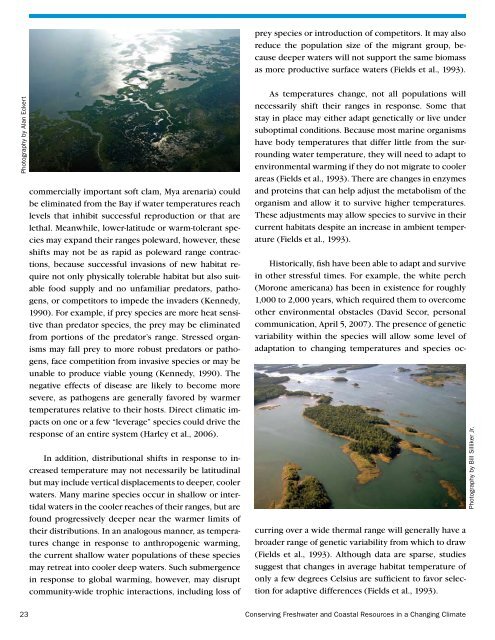Conserving Freshwater and Coastal Resources in a Changing Climate
Conserving Freshwater and Coastal Resources in a Changing Climate
Conserving Freshwater and Coastal Resources in a Changing Climate
Create successful ePaper yourself
Turn your PDF publications into a flip-book with our unique Google optimized e-Paper software.
prey species or <strong>in</strong>troduction of competitors. It may also<br />
reduce the population size of the migrant group, because<br />
deeper waters will not support the same biomass<br />
as more productive surface waters (Fields et al., 1993).<br />
Photography by Alan Eckert<br />
commercially important soft clam, Mya arenaria) could<br />
be elim<strong>in</strong>ated from the Bay if water temperatures reach<br />
levels that <strong>in</strong>hibit successful reproduction or that are<br />
lethal. Meanwhile, lower-latitude or warm-tolerant species<br />
may exp<strong>and</strong> their ranges poleward, however, these<br />
shifts may not be as rapid as poleward range contractions,<br />
because successful <strong>in</strong>vasions of new habitat require<br />
not only physically tolerable habitat but also suitable<br />
food supply <strong>and</strong> no unfamiliar predators, pathogens,<br />
or competitors to impede the <strong>in</strong>vaders (Kennedy,<br />
1990). For example, if prey species are more heat sensitive<br />
than predator species, the prey may be elim<strong>in</strong>ated<br />
from portions of the predator’s range. Stressed organisms<br />
may fall prey to more robust predators or pathogens,<br />
face competition from <strong>in</strong>vasive species or may be<br />
unable to produce viable young (Kennedy, 1990). The<br />
negative effects of disease are likely to become more<br />
severe, as pathogens are generally favored by warmer<br />
temperatures relative to their hosts. Direct climatic impacts<br />
on one or a few “leverage” species could drive the<br />
response of an entire system (Harley et al., 2006).<br />
In addition, distributional shifts <strong>in</strong> response to <strong>in</strong>creased<br />
temperature may not necessarily be latitud<strong>in</strong>al<br />
but may <strong>in</strong>clude vertical displacements to deeper, cooler<br />
waters. Many mar<strong>in</strong>e species occur <strong>in</strong> shallow or <strong>in</strong>tertidal<br />
waters <strong>in</strong> the cooler reaches of their ranges, but are<br />
found progressively deeper near the warmer limits of<br />
their distributions. In an analogous manner, as temperatures<br />
change <strong>in</strong> response to anthropogenic warm<strong>in</strong>g,<br />
the current shallow water populations of these species<br />
may retreat <strong>in</strong>to cooler deep waters. Such submergence<br />
<strong>in</strong> response to global warm<strong>in</strong>g, however, may disrupt<br />
community-wide trophic <strong>in</strong>teractions, <strong>in</strong>clud<strong>in</strong>g loss of<br />
As temperatures change, not all populations will<br />
necessarily shift their ranges <strong>in</strong> response. Some that<br />
stay <strong>in</strong> place may either adapt genetically or live under<br />
suboptimal conditions. Because most mar<strong>in</strong>e organisms<br />
have body temperatures that differ little from the surround<strong>in</strong>g<br />
water temperature, they will need to adapt to<br />
environmental warm<strong>in</strong>g if they do not migrate to cooler<br />
areas (Fields et al., 1993). There are changes <strong>in</strong> enzymes<br />
<strong>and</strong> prote<strong>in</strong>s that can help adjust the metabolism of the<br />
organism <strong>and</strong> allow it to survive higher temperatures.<br />
These adjustments may allow species to survive <strong>in</strong> their<br />
current habitats despite an <strong>in</strong>crease <strong>in</strong> ambient temperature<br />
(Fields et al., 1993).<br />
Historically, fish have been able to adapt <strong>and</strong> survive<br />
<strong>in</strong> other stressful times. For example, the white perch<br />
(Morone americana) has been <strong>in</strong> existence for roughly<br />
1,000 to 2,000 years, which required them to overcome<br />
other environmental obstacles (David Secor, personal<br />
communication, April 5, 2007). The presence of genetic<br />
variability with<strong>in</strong> the species will allow some level of<br />
adaptation to chang<strong>in</strong>g temperatures <strong>and</strong> species occurr<strong>in</strong>g<br />
over a wide thermal range will generally have a<br />
broader range of genetic variability from which to draw<br />
(Fields et al., 1993). Although data are sparse, studies<br />
suggest that changes <strong>in</strong> average habitat temperature of<br />
only a few degrees Celsius are sufficient to favor selection<br />
for adaptive differences (Fields et al., 1993).<br />
Photography by Bill Silliker Jr.<br />
23<br />
<strong>Conserv<strong>in</strong>g</strong> <strong>Freshwater</strong> <strong>and</strong> <strong>Coastal</strong> <strong>Resources</strong> <strong>in</strong> a Chang<strong>in</strong>g <strong>Climate</strong>

















